You'll need three core ingredients to make solid perfumes: natural waxes like beeswax for structure, essential or fragrance oils for scent, and carrier oils like jojoba for smooth application. Essential tools include measuring equipment (digital scale, pipettes), heat-safe containers, and safety gear (gloves, goggles). Don't forget storage containers for your final product. Understanding the proper ratios and techniques will help you create professional-quality solid perfumes.
The Role of Natural Waxes in Solid Perfumes

Natural waxes serve as the backbone of solid perfumes, providing both structure and stability to these portable scents.
When you're crafting solid perfumes, you'll find that beeswax is a popular choice for its gentle skin compatibility and ability to hold fragrances effectively. You can also opt for vegan alternatives like candelilla wax or eco-friendly palm wax.
These natural waxes don't just give your perfume its solid form – they're working hard to maintain the fragrance's potency over time. Too much wax can result in perfumes that don't absorb well into the skin.
Natural waxes are silent guardians of your fragrance, holding its essence intact while providing the perfect solid structure.
By blending waxes like shea butter with other varieties, you'll create a creamier texture that's easy to apply. Plus, many natural waxes offer bonus skincare benefits, such as moisturizing properties.
They're essential for ensuring your perfume stays strong and stable while remaining gentle on your skin.
Essential and Fragrance Oils Selection Guide
With your solid perfume base established, selecting the right fragrance oils becomes your next creative step. You'll want to layer your scents by choosing oils from three distinct categories: top, middle, and base notes. Start with base notes as your foundation, then build up with complementary middle and top notes. For optimal safety and skin-friendliness, consider using natural essential oils rather than synthetic fragrances.
| Note Type | Examples | Best For |
|---|---|---|
| Top Notes | Bergamot, Lemon | First Impression |
| Middle Notes | Lavender, Geranium | Main Character |
| Base Notes | Sandalwood, Cedarwood | Lasting Power |
Remember to include fixatives like vetiver or cedarwood to extend your fragrance's longevity. When working with citrus oils like bergamot, be mindful of photosensitivity. Always dilute your oils properly and test small amounts on your skin before creating larger batches.
Carrier Oils for Perfect Consistency
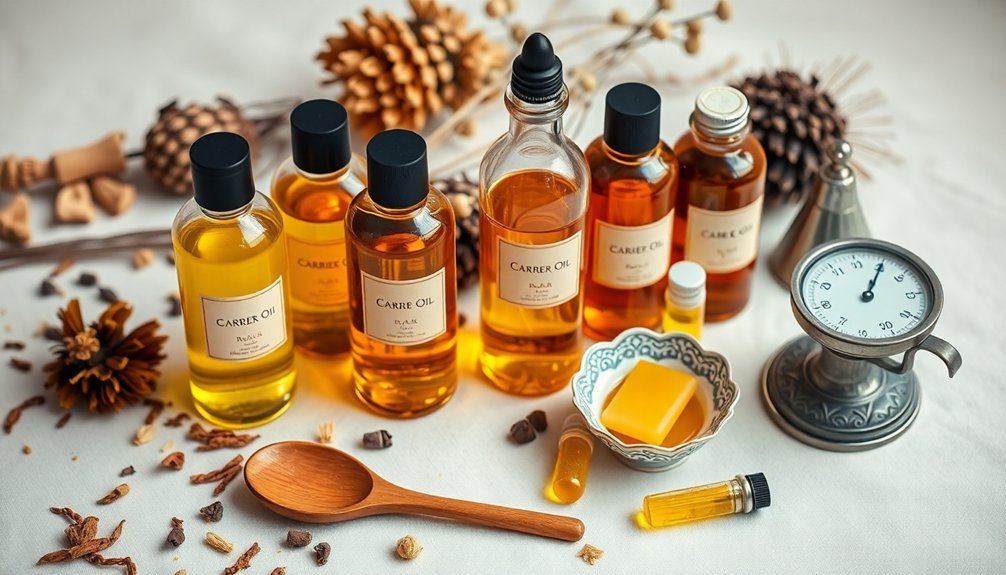
When selecting carrier oils for your solid perfume, you'll want to focus on premium options like jojoba and sweet almond oil that offer both stability and excellent absorption.
Your choice of base oils directly impacts how well your fragrance will last and how it feels on your skin, with lighter oils like grapeseed providing a fresh finish while richer ones like apricot kernel create a more luxurious texture. A proper blend creates a natural product that nourishes skin deeply, delivering essential fatty acids and vitamins.
To achieve the perfect consistency, you'll need to blend your chosen carrier oils in appropriate ratios with beeswax, typically using about one tablespoon of oil per recipe.
Choosing Quality Base Oils
Selecting the right carrier oils forms the foundation of any successful solid perfume formulation.
You'll want to focus on oils that complement your fragrance while offering ideal skin compatibility and absorption.
Jojoba oil stands out as your most versatile choice, mimicking your skin's natural oils while maintaining fragrance integrity.
For sensitive skin, consider sweet almond or grapeseed oil – they're lightweight and absorb quickly.
If you're crafting tropical or summer scents, mango seed oil adds a complementary aroma while extending wear time.
You can also pair different carrier oils to achieve the perfect balance.
Try combining fractionated coconut oil's longevity with rosehip seed oil's complexity, or blend sunflower oil's light texture with apricot kernel oil's silky finish.
Each combination offers unique benefits for your solid perfume creation.
Blending Oil Ratios Effectively
The perfect solid perfume emerges from precise carrier oil ratios that determine its final consistency and wearability.
You'll want to start with a base of jojoba or grapeseed oil, as they're lightweight and absorb quickly into your skin. For ideal results, consider using refined coconut oil instead of virgin coconut oil to avoid overwhelming coconut scents in your blend.
When mixing your carrier oils, you'll need to maintain proper ratios with your beeswax – typically 2:1 to 4:1 beeswax to oil ratio.
Remember that climate affects your final product's consistency, so you'll need less beeswax in colder environments. Sweet almond oil can be an excellent alternative to jojoba, offering similar nourishing properties with its mild, sweet undertones.
Must-Have Tools for Perfume Making
Creating solid perfumes requires a well-organized workspace equipped with essential tools for measuring, blending, and storing your fragrances. You'll need protective gear, including gloves and safety glasses, to handle ingredients safely. For precise measurements and mixing, stock up on glass stirring rods, pipettes, and eye-droppers.
| Tool Category | Essential Items | Purpose |
|---|---|---|
| Storage | Bottles, Tins, Labels | Contain and identify blends |
| Blending | Glass Rods, Spatulas | Mix ingredients properly |
| Safety | Gloves, Masks, Glasses | Protect from irritants |
Don't forget to keep paper towels and parchment paper handy for clean-up. For packaging your finished creations, you'll want black slimline lip balm tubes or small lockets – they're perfect for solid perfumes and make your products look professional.
Measuring and Temperature Control Equipment
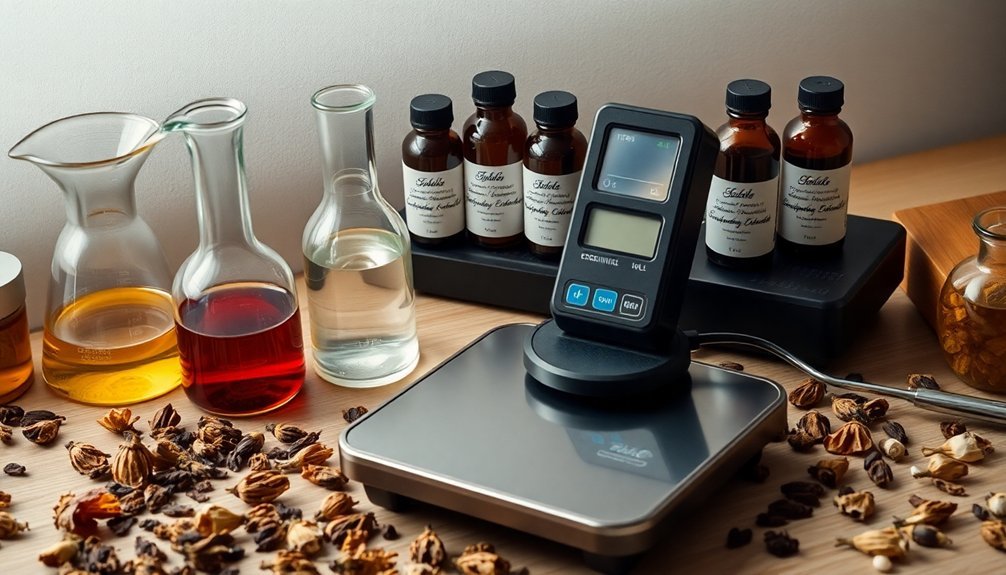
Precise measurements and temperature control make or break your perfume-making success.
You'll need a digital scale with an accuracy of ±0.003 grams and a maximum capacity of 200 grams to guarantee consistent fragrance formulations. Digital scales offer efficiency and precision that's essential for replicating your recipes.
For temperature-sensitive processes, especially when melting wax for solid perfumes, you'll want a reliable thermometer. It helps you maintain the right heat levels and prevents overheating, which can damage your ingredients' chemical composition.
Don't forget to keep your tools clean and calibrated. Regularly sterilize your equipment with ethanol to avoid cross-contamination between different scents. This practice prevents residue buildup and guarantees your measurements stay accurate over time.
Container Options and Storage Solutions
With your ingredients measured and equipment ready, selecting the right container will determine your solid perfume's portability and longevity.
You'll find options ranging from compact travel sizes (2.3g) to larger home-use containers (10g), available in materials like metal, glass, and plastic.
Choose containers that protect your solid perfume from moisture, heat, and direct sunlight to maintain fragrance quality.
If you're environmentally conscious, you'll appreciate the eco-friendly and refillable options now available.
For business purposes, you can customize containers with unique branding, colors, and designs that match your aesthetic preferences.
Store your solid perfumes in cool, dry places and consider using protective packaging during transport.
Whether you prefer minimalist designs or luxurious aesthetics, you'll find containers that suit both your practical needs and style preferences.
Safety Equipment and Workspace Setup
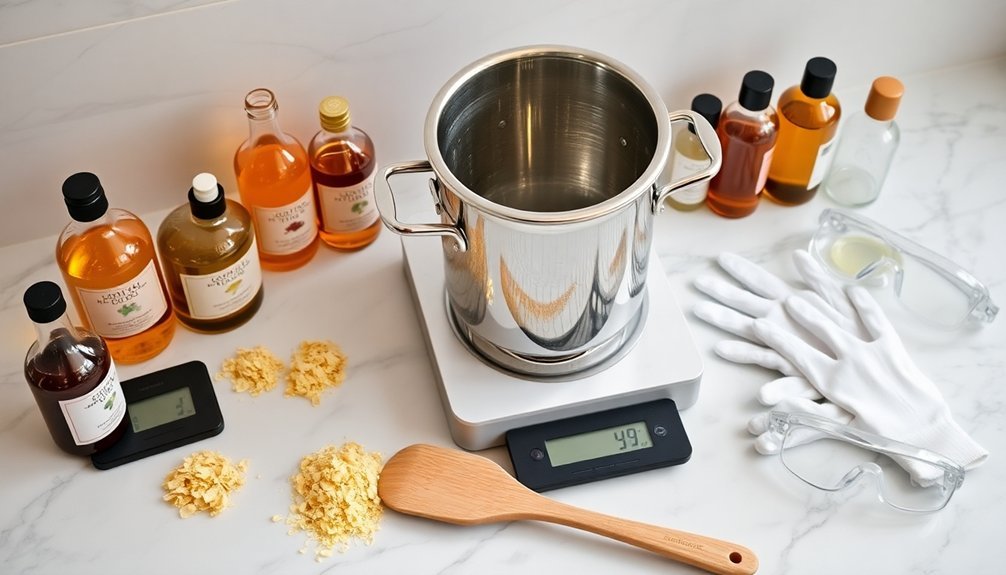
You'll need a well-ventilated workspace that allows proper airflow to prevent the buildup of fragrance vapors while creating solid perfumes.
Protective gear, including nitrile gloves, safety goggles, and a lab coat or apron, should be worn at all times to guard against spills and splashes.
Keep an eye wash station and first aid kit within easy reach, and guarantee your workspace stays organized and free from clutter to maintain a safe environment.
Workspace Ventilation Requirements
Proper ventilation serves as the cornerstone of a safe and effective solid perfume workspace.
You'll need a well-maintained HVAC system that guarantees consistent air circulation throughout your work area. Install air purifiers to remove airborne contaminants, particularly when working with concentrated fragrances.
Don't overlook the importance of regular air quality testing by an industrial hygiene professional.
While OSHA doesn't specify exact CFM requirements, you're still responsible for maintaining healthy indoor air quality. Keep your ventilation equipment in top condition through routine maintenance, and use high-quality air filters in your HVAC system.
Remember to control temperature and humidity levels, and guarantee your workspace is properly pressurized to prevent outside pollutants from entering.
These measures will help create a safer environment for crafting your solid perfumes.
Protective Gear Guidelines
Because working with hot waxes and concentrated fragrances poses inherent risks, thorough safety gear forms the foundation of solid perfume creation.
You'll need to protect yourself from potential burns, spills, and eye irritation while maintaining a clean, organized workspace. Always wear heat-resistant gloves, an apron, and safety goggles when handling hot ingredients.
Don't forget to secure your hair with a net and wear closed-toe shoes to prevent accidents.
Essential protective equipment includes:
- Heat-resistant gloves to handle hot containers safely
- Full-coverage apron to shield clothing from spills
- Safety goggles or glasses for eye protection
- Hair net to prevent contamination
- Closed-toe shoes to protect feet from accidents
Before starting, verify your workspace is clean, well-lit, and clutter-free.
Keep emergency contacts and a fire extinguisher within reach.
Natural Colorants and Additives
Nature offers a vibrant palette of colorants and additives that can transform solid perfumes into personalized works of art. You'll find plant-based options like spirulina, turmeric, and matcha that add beautiful hues while maintaining natural integrity.
Clay powders can contribute earthy tones and skin benefits.
For your base, consider versatile carrier oils such as jojoba or sweet almond oil, which provide excellent moisturizing properties. Essential oils like lavender, tea tree, and ylang-ylang not only add fragrance but also offer therapeutic benefits.
Don't forget the importance of waxes and resins – beeswax serves as your primary stabilizer, while carnauba wax improves texture. Natural resins like dammar and myrrh can add depth to your fragrance while contributing to the perfect consistency.
Blending and Mixing Instruments
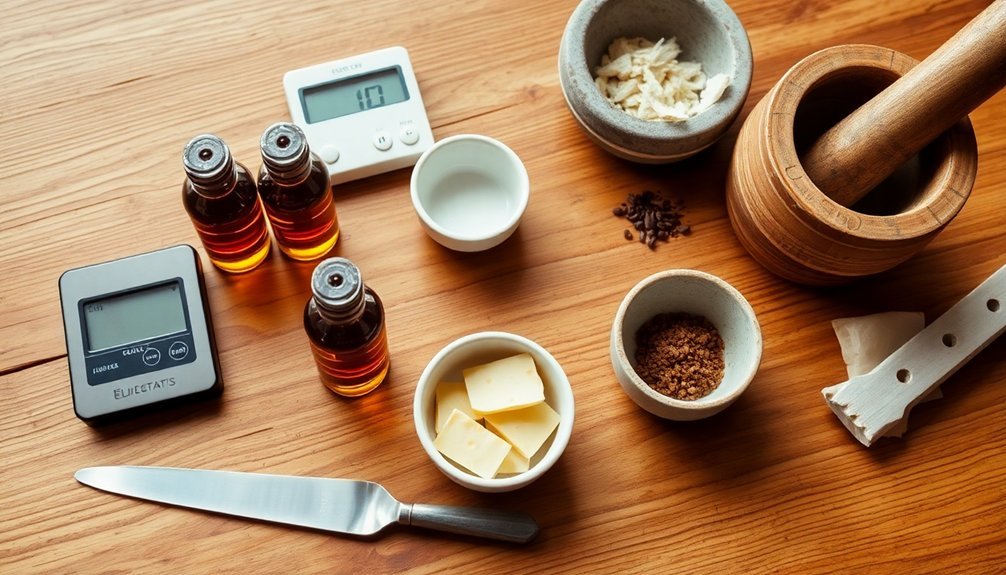
Quality blending and mixing instruments serve as the foundation for creating consistent, professional-grade solid perfumes. You'll need precise tools to measure, mix, and handle your ingredients safely. A reliable scale and set of measuring cups guarantee accuracy, while protective gear like rubber gloves keeps you safe during the blending process.
For precise fragrance work, you'll want both micropipettes and dropper pipettes to handle your essential oils with care.
- Stainless steel spoons and glass stirring rods for durability and precision
- Glass measuring jugs and beakers for experimental trial blending
- Thermometers to monitor temperature during wax melting
- Amber or cobalt blue glass bottles to protect your blends
- Spreadsheets or calculators to record and replicate successful formulas
Packaging Materials and Presentation Supplies
Selecting the right packaging materials and presentation supplies proves essential for protecting and showcasing your solid perfumes.
You'll find natural kraft paper tubes offer an eco-friendly option with a rustic appeal, while C1S paper tubes provide a smoother finish for enhanced visuals. If you're seeking durability, consider metal containers in gold or silver finishes that you can refill repeatedly.
For a luxurious touch, elegant cases and lockets combine fashion with fragrance, making them perfect for gifting.
When you're mass-producing, filling trays will streamline your process. Don't forget to include step-by-step instructions for DIY users.
To align with sustainable practices, opt for biodegradable or recyclable materials. Choose compact, travel-sized containers that'll fit easily in bags while maintaining a sophisticated unboxing experience for your customers.
Frequently Asked Questions
How Long Does a Solid Perfume Typically Last Before the Scent Fades?
You'll notice your solid perfume's scent typically lasts 2-4 hours on your skin, though it's longer than liquid perfumes. With proper storage and application to moisturized skin, you'll maintain its potency.
Can I Melt and Reuse Solid Perfume if I Don't Like the Scent?
Yes, you can re-melt your solid perfume if you don't like the scent. Just heat it gently and add new fragrances, but be careful not to overheat as this could damage the essential oils.
What's the Shelf Life of Homemade Solid Perfumes?
Your homemade solid perfumes will typically last 6-12 months when stored properly. You'll get the best shelf life by keeping them in a cool, dark place and using airtight containers.
Will Solid Perfumes Stain Clothing When Applied?
When properly applied to your skin, solid perfumes shouldn't stain clothing. However, if you accidentally get the perfume on fabric, it can leave oily marks. Always let it dry before clothing contact.
Can I Add Preservatives to Extend My Solid Perfume's Longevity?
You don't need preservatives in solid perfumes as they're naturally stable. Instead, add vitamin E oil as an antioxidant to prevent rancidity, and focus on proper storage in cool, dark places for longer shelf life.

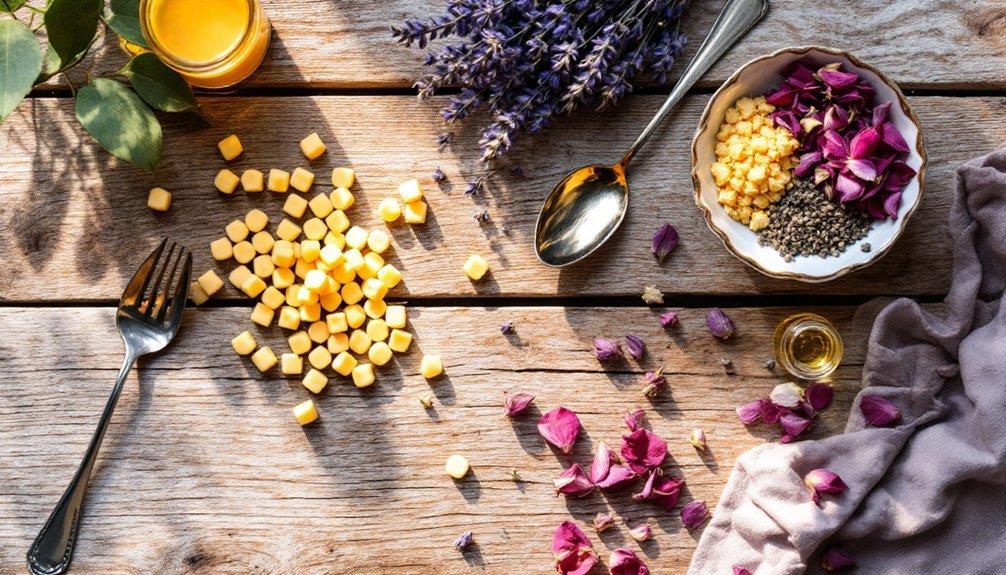
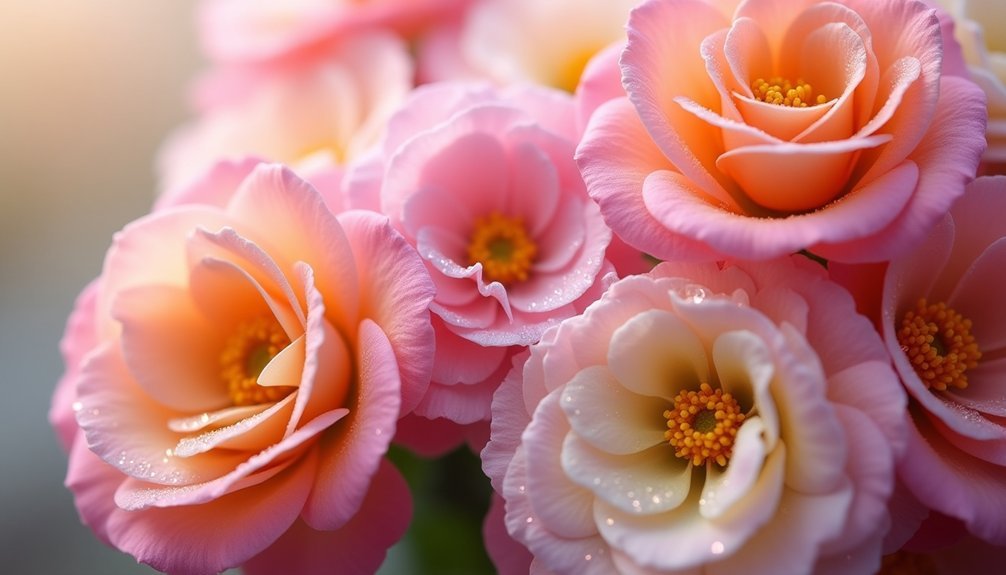
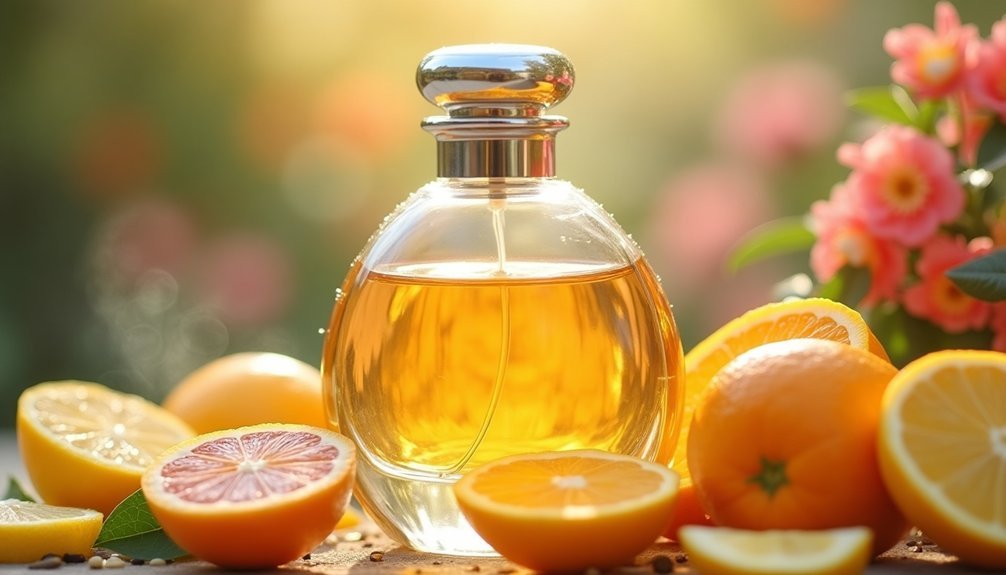
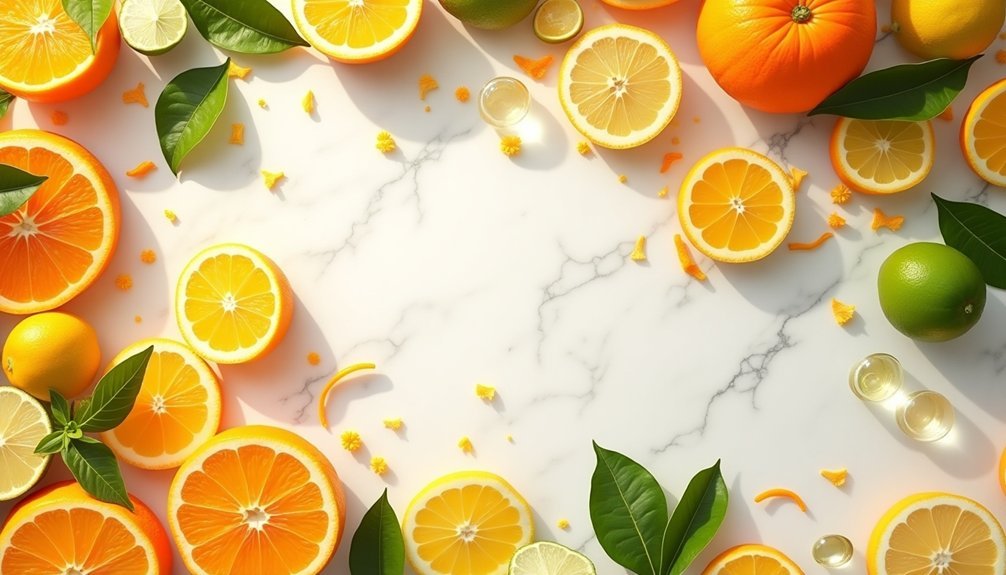
Leave a Reply